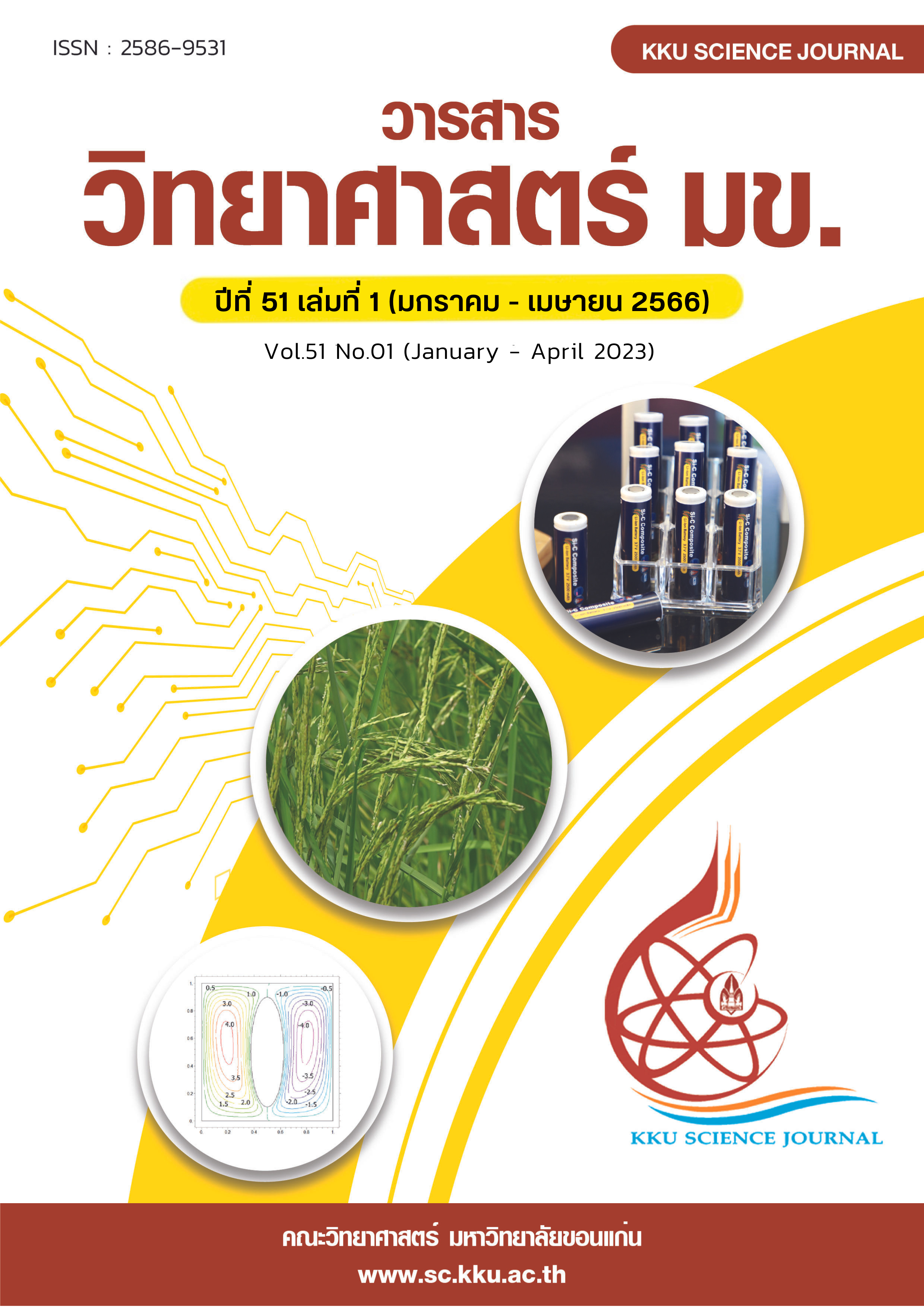Study on the Preparation of Biodegradable Plastic from Rice Straw and Chitosan
Main Article Content
Abstract
Bioplastics made from natural fibers to replace synthetic polymers have been receiving increased attention due to their biodegradability. In this study, bioplastics were prepared using cellulose fiber from rice straw and chitosan as the polymeric matrices. The parameters included different ratios of digested rice straw fiber (DRF) and bleached rice straw fiber (BRF), which were varied at ratios of 2.0:0.0, 1.5:0.5, 0.5:1.5, and 0.0:0.2. The composition of 50% fiber was added with 25% chitosan and 25% glycerol based on total solid via wet mixing and pouring on plate molding and drying to produce bioplastic. The synthesized bioplastics were characterized using tensile test, X - ray diffraction (XRD), thermogravimetric analysis (TGA), and scanning electron microscopy (SEM). The results showed that increasing DRF enhanced the tensile strength of the film from 3.4 to 5.9 MPa and decreased elongation at break from 9.0 to 6.0 percent. The XRD testing results reflected good bonding between rice straw fibers and chitosan matrices. The TGA results showed that it can resist heat up to 160 °C, and from the results of SEM, the plastics have a rough surface. Moreover, the bioplastics reached 58.83% degradation within 60 days of the test. Bioplastics made from rice straw have a high potential for environmentally friendly alternatives to replace petroleum-based synthetic plastics.
Article Details

This work is licensed under a Creative Commons Attribution-NonCommercial-NoDerivatives 4.0 International License.
References
กรมการข้าว. (2562). กรมการข้าวแนะชาวนาใช้ประโยชน์จากฟางข้าว ลดมลพิษ-สร้างรายได้. แหล่งข้อมูล: http://webold.ricethailand.go.th/web/index.php/mactivities/5613-2019-04-25-09-16-05. ค้นเมื่อวันที่ 15 มีนาคม 2566.
ภาวิณี เทียมดี และกวินนา สุขสำราญ. (2562). การพัฒนาฟิล์มย่อยสลายได้จากแป้งมันแกวเพื่อประยุกต์ใช้เป็นถุงเพาะชำ. วารสารวิชาการและวิจัย มทร.พระนคร 14(1): 1-14.
วยากรณ์ เพ็ชญไพศิษฏ์ และปาณิศา แสงนาค. (2560). บรรจุภัณฑ์ต้านจุลชีพจากเซลลูโลส ไคโตซาน และไคโตซานดัดแปร-ซิลเวอร์คอมเพล็กซ์. Thai Science and Technology Journal (TSTJ) 28(5): 759-773.
Chantawee, K. and Riyajan, S.A. (2019). Effect of glycerol on the physical properties of carboxylated styrenebutadiene rubber/cassava starch blend films. Journal of Polymers and the Environment 27: 50–60.
Edhirej, A., Sapuan, S.M., Jawaid, M. and Zahari, N.I. (2018). Preparation and Characterization of Cassava Starch/Peel Composite Film. Journal of Polymer Composites 39(5): 1383-1778.
Elhussieny, A., Faisal, M., Angelo, G., Nesma T.A., Everitt, N.M. and Fahim, I.S. (2020). Journal of Ain Shams Engineering 11: 1219–1226.
Farahnaky, A., Saberi, B. and Majzoobi, M. (2013). Effect of glycerol on physical and mechanical properties of wheat starch edible films. Journal of Texture Studies 44: 176-186.
Garrote, G., Domínguez, H.J.C. and Parajó, J.C. (2002). Autohydrolysis of corncob: study of non-isothermal operation for xylooligosaccharide production. Journal of Food Engineering 52: 211-218.
Ghasemlou, M., Aliheidari, N., Fahmi, R., Shojaee-Aliabadi, S., Keshavarz, B., Cran, M.J. and Khaksar, R. (2013). Physical, mechanical and barrier properties of corn starch films incorporated with plant essential oils. Journal of Carbohydrate Polymers 98: 1117–1126.
Grande, R. and Carvalho, A.J.F. (2011). Compatible ternary blends of chitosan/poly (vinyl alcohol)/poly (lactic acid) produced by oil-in-water emulsion processing. Journal of Biomacromolecules 12: 907–914.
Ibrahim, M.I.J., Sapuan, S.M., Zainudina, E.S. and Zuhri, M.Y.M. (2019). Physical, thermal, morphological, and tensile properties of cornstarch-based films as affected by different plasticizers. International Journal of Food Properties 22(4): 925–941.
Marichelvam, M.K., Jawaid M. and Asim M. (2019). Corn and Rice Starch-Based Bio-Plastics as Alternative Packaging Materials. Journal of Fibers 7(4): 32-46.
Paradika, Y. P. M. (2017). Effect of Plasticizer and Chitosan Composition on the Plastic Biodegradable Quality from Starch Cassava Rubber (Manihot Glaziovii) as Alternative Plastic. In: ASEAN / Asian Academic Society International Conference (AASIC) Proceeding Series, The 5th AASIC. 27 July 2017, Thailand 83-88.
Pitiphatharaworachot, S. and Puangsin, B. (2017). Effect of Glycerol on Physical and Thermal Properties of Tapioca Starch Films. In: Proceeding of the 55th Kasetsart University Annual Conference March 2017. Kasetsart University, Bangkok. 786-793.
Samsalee, N. and Sothornvit, R. (2019). Development and characterization of porcine plasma protein-chitosan blended films. Journal of Food Packaging and Shelf Life 22: 100406.
Varalakshmi, B. (2015). Biodegradation of polythene bag using bacteria isolated from soil. International Journal of Cur-rent Microbiology and Applied Sciences 4: 674–680.
Vargas, M., Albors, A., Chiralt, A. and González-Martínez, C. (2011). Water interactions and microstructure of chitosan–methylcellulose composite films as affected by ionic concentration. Journal of LWT – Food Science and Technology 44: 2290–2295.


